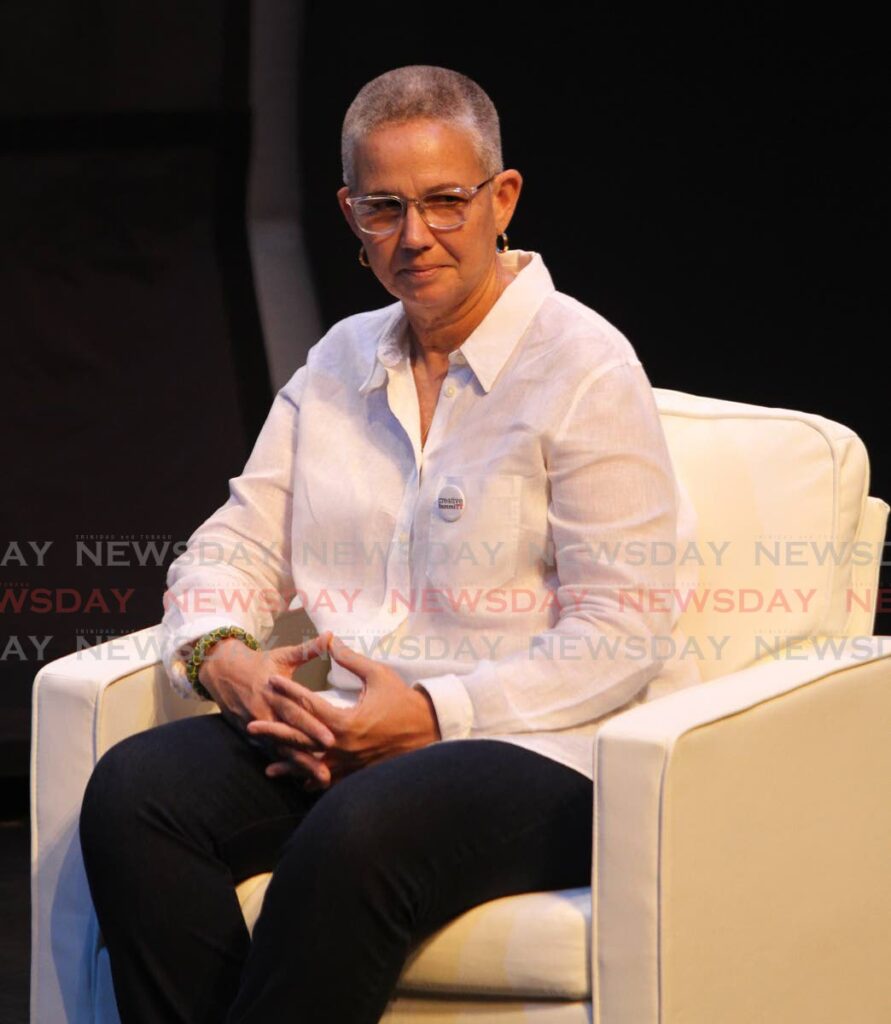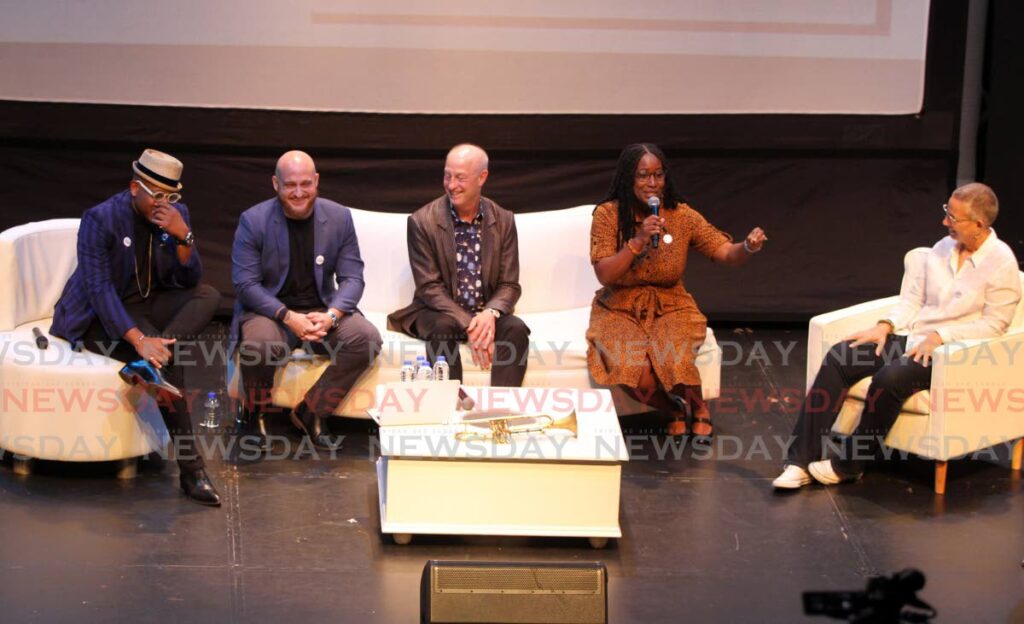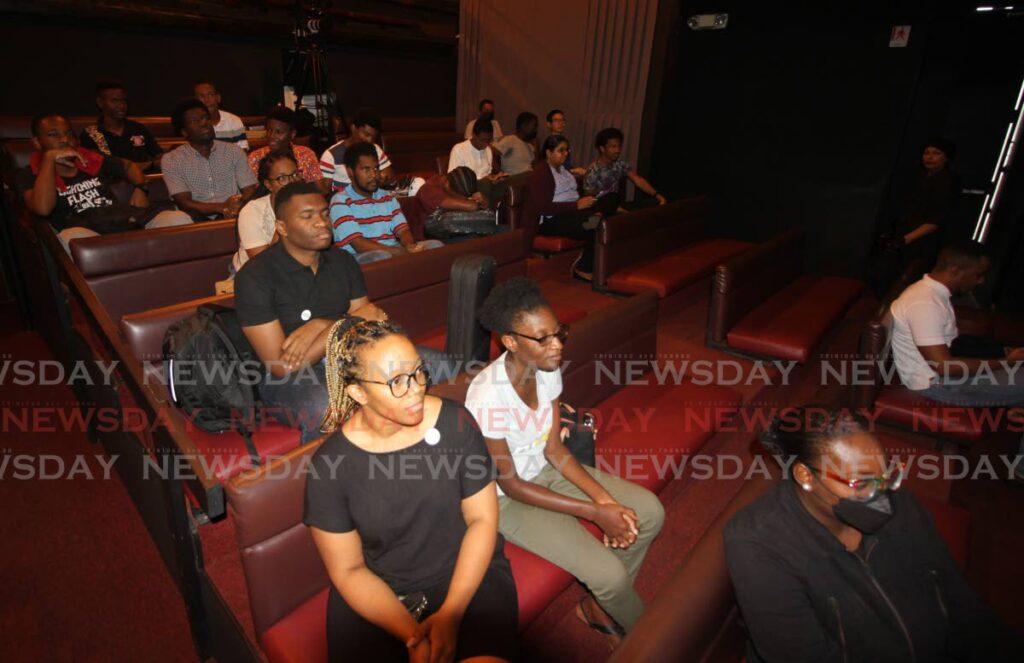Creative SummiTT looks at how to help artists grow as a community

Skill-building, entrepreneurship, and community building are key aspects in the development of visual artists and musicians, as well as other creatives. This was the message presented at the Creative SummiTT conference, chaired by renowned jazz trumpeter Etienne Charles, at the Little Carib Theatre and Folkhouse, Woodbrook, on Friday.
The panel consisted of steelpan scholar and UTT assistant professor Dr Mia Gormandy-Benjamin, Frost School of Music dean Shelton Berg, visual artist and Backyard Design Company owner Nicholas Huggins, and photographer, filmmaker, and historian Maria Nunes.
Gormandy-Benjamin said skill-building was a never-ending process, no matter how long people had been practising their craft.
“There are literally no shortcuts to getting better at what you do. I always used to wonder why I had to practise my scales when I just wanted to play, but the later parts of the process are built on that early foundation of practice. Creatives should say yes when presented with opportunities.”
Gormandy said creatives should be open-minded and humble, as people seen as easy to work with got more opportunities. She said it was okay to admit nobody knows everything. She said people should love what they do as it made it easier to overcome stumbling blocks.
Responding to a question from Nunes about the need for mentorship, Gormandy said mentorship was important.
“I had really good teachers who were willing to tell me what I could improve on, as well as when they couldn’t help me. Sometimes the student outgrows the teacher, and if the mentor is humble enough, they can pass the student to someone who can help their growth. Also, you don’t have to have only one mentor, especially if you have diverse interests.”
Berg said there were people who were immensely talented and others who practised their craft.

“People with immense talent don't like to practice because things come easy to them, but there are other things that don't come easy to them, and they sometimes fall to the wayside because they don't work on their Achilles heel. Other artists are a slow burn and work at their skill, and often overtake the people with talent.”
He said mentors should help each student develop their own uniqueness, which could be difficult.
Huggins said he encouraged the junior graphic designers in his business to develop the skill sets that go along with the industry. He said work ethic trumps talent.
Nunes said her mentorship came not only in person, but through studying the work of artists she admired.
“It doesn’t have to be something profound, for example photographer Abigail Hadeed taught me a naming system that has saved my life. I don’t study just photographers, but other artists, like in working with Etienne I’ve seen that he practises every day, whatever else is going on. I’m a firm believer in observing how others do their work.”
Charles said another type of learning happens while performing onstage with other musicians. He and Berg performed an impromptu duet to show how they improvised on each other’s performances.
Berg shared a story of being asked to transcribe arrangements for a recording of Ray Charles singing with a big band in 1978. He said he preferred writing a new arrangement rather than transcribing one, even though he had perfect pitch.
Etienne said transcribing a score is the best way to get into the mind of a composer.
“The process is key: by transcribing, you imitate what the composer was doing, assimilate or learn from it, and innovate by building on what you learned.”

All the panellists noted that downtime was key for a creative person to maintain their energy. Two people said they had been hospitalised because they hadn’t given themselves enough time between projects.
Nunes said as a freelancer, she was often terrified of taking time off because she was afraid of losing work. She said it was about managing time well enough so that you don’t burn out during your working time.
In response to an audience question, Huggins said young people should initially get a job, ideally one they could learn from, which would allow them to get a credit rating, before becoming entrepreneurs.
Asked about how to set rates, Huggins said people should charge what they were worth. He said he shared rates with fellow graphic designers, and if clients were accepting quotes too quickly, the rates were probably too low. Gormandy-Benjamin said it was important to understand the scope of the job as often, people take advantage of musicians because they were already present at an event.
Nunes said she still struggled with setting rates, as, especially in TT, so many people have cameras that she had lost jobs by the slimmest of margins. Charles said the US has standard union rates, but in developing freelance rates, people should think about all the factors they have to put in, like meals, travelling, gas, taxes, etc. He said sometimes it was cheaper to not take a job.
Asked about his creative process, Berg said it starts with a feeling. He said every creator has two wells.

“We have a technical well and a spiritual well. The technical well is the things you learn how to do, the scales and arpeggios and hip licks, and the spiritual well is everything we can feel and imagine, and so for me the creative process is trying to live in the spiritual well and draw unconsciously from the technical well.”
Gormandy-Benjamin said she carried a little notebook that she wrote ideas in which became a library of ideas for her next composition or show.
Asked about money management for creatives, as they didn’t usually have a steady income, Huggins said he felt this shouldn’t be the case, but if it was, they needed to figure out how to get enough jobs to support themselves.
Charles said in the professional music industry, people got paid long after their performances, so he got to know accounting officers and ensured all his documents were in order. He said having a float to pay for pre-performance expenses such as plane tickets and visas was essential, as was saving 30-50 per cent of income when received.
Charles said the work produced was a creative’s calling card, as people would seek out the artist if they enjoyed the work.
An audience member asked what they should tell their parents if the parent was telling them they would be disowned for pursuing a creative career.
Huggins said they could show examples of what artists were doing in that particular field. Berg said the skills learned while studying art were sought in a variety of industries.
Nunes said what was actually helpful was for new creatives to quietly do their art while doing a full-time job to “figure out who you are and what your specialness is, while building up your confidence. A lot of people can't go out immediately and do this full-time.”
Charles said the best way to convince parents was for the creative to do well in their field and gain recognition.
“We in the Caribbean don’t allow for things to grow. We are now for now. Most parents will come around once you start getting recognised.”
He said people who were getting into a saturated field, like pan in TT, should find something unique about what they enjoy and people would gravitate to it. Nunes agreed, and said it should be deeply authentic.
In the community building segment, Nunes said she did not set out to document Carnival but realised it was something which she enjoyed.
“I am driven most of all by documenting the life and process of artists. In building community, it’s about cluing in to people who are like-minded and had similar value systems as you. I see my work as part of artistic community. In documenting Carnival all over the islands, I have come to understand my Caribbean-ness.
“In TT we are very consumed with ourselves and we lose sight of being part of a region with shared history and culture. We have so much to learn from each other, but we compete with each other. Also it’s very difficult to travel between islands, so the economics of the world keep Caribbean people apart.”
She exhorted artists to take their inspiration from the Caribbean, instead of going outside the region. Nunes said she gives back to the artists she photographs by readily sharing images with them, crediting them in their images, and taking time to get to know them.
Charles said it was important for musicians to record their process, as what they see can influence what they hear.
In response to an audience question about community, Gormandy-Benjamin said community should give a sense of belonging and be comprised of like-minded people. She said it didn’t always happen on purpose. Nunes said if someone felt they had outgrown a community, they should be graceful in leaving, as they never knew if they would need that community again.
Gatekeeping was one of the final topics raised, where experienced artists were not passing on their knowledge to younger ones. Charles said he had experienced it for years.
“It’s a cultural issue, which I think goes back to the plantation, when skill created favour among those with the ability to take you out of the worst conditions. Now, people will know something and won't show it to others because they’re afraid of it coming out of their pocket, that's how the competition is now. For example, the quality of soca and calypso has dropped because people weren't teaching what they knew, because they said they were so busy recording and doing things at the time.
“I would say if people are being difficult, there’s always a way around them, and if not, ask them directly what’s the issue, why do they feel they can’t show you what you want to know?”
Nunes said in TT, there was not a sufficient depth of appreciation for artists.
“We ride on the backs of our traditional mas artists. Lots of our creatives are window dressing in people’s minds, even though we draw on them for our emotional wellbeing. It’s very hard to get funding for workshopping works of music or theatre, which is part of what artists need. We are not serious about investing in what artists do.”


Comments
"Creative SummiTT looks at how to help artists grow as a community"